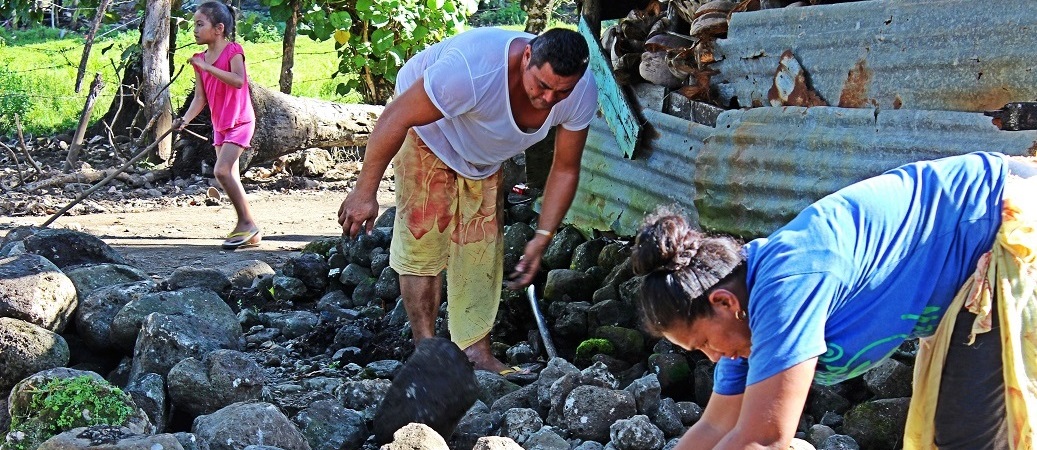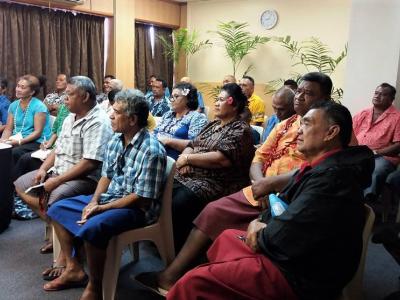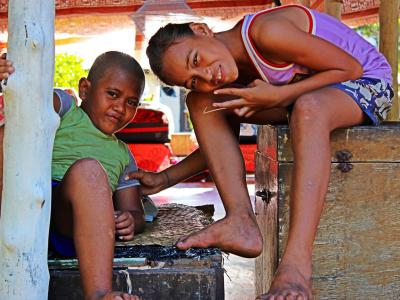
In Samoa, a climate change-related increase in natural disasters has put communities and economies at risk. The project Enhancing Resilience of Coastal Communities of Samoa to Climate Change (2012-2018) sought to enhance the resilience of coastal communities through a set of interventions at the community and sub-national policy levels.
The project implemented on-the-ground coastal adaptation measures, addressing climate change impacts on key infrastructure elements and coastal ecosystems. In addition to this, and to ensure that investments are long-lasting and sustainable, it focused on strengthening institutional policies and capabilities to provide an enabling environment for climate resilient coastal development. The project has now closed.
- Community
- National Governments
Coastal Communities
- Ministry of Natural Resources and Environment (MNRE), Government of Samoa
- United Nations Development Programme (UNDP)
- Adaptation Fund
Climate change-induced modifications to the rural coastal environment are potentially significant to nearly 80% of the country‘s population. Assets are at risk from continued coastal erosion. The continued further loss of agriculturally productive land will threaten livelihoods and food supplies, and may force further deforestation in the more upland portions of catchments contributing to further soil erosion and increased flooding risk.
This project provided a vehicle to implement the approved Coastal Infrastructure Management (CIM) Plans on the ground as a practical community-based response to adaptation. It enabled the necessary technical and financial resources to be used in a programmatic manner which, when combined with parallel complementary works undertaken through the CRIP/PPCR will result in a countrywide adaptation response for coastal management. The implementation of responses was supported by the programme through site-specific design of adaptation interventions and active community engagement in the process.
The programme served to implement the CIM Strategy, which was originally prepared in 2000 and revised in 2006 to include specific reference to CC related issues. In particular, the predicted hazard zones were reviewed against the NAPA data (2005) and inter-alia the Climate Risk Profiles (2007) and reference was made to expected land use impacts from more frequent and intense cyclone events.
The programme had a 3-pronged approach:
- First, it targeted on-the-ground implementation of coastal adaptation measures, addressing climate change impacts on key infrastructure elements and coastal ecosystems in an integrated way. Integration was achieved within the framework of a comprehensive village land use plan – the CIM Plan.
- The second prong strengthened institutional policies and capacities to provide an enabling environment for climate resilient coastal development.
- The third area of focus was on the systematic capture and dissemination of knowledge and lessons learned to aid and inform further implementation and pursuit of climate resilient development.
** The following key stakeholders were consulted during the formulation of this programme proposal:
- Ministry of Finance
- National Climate Change Country Team
- Ministry of Natural Resources and Environment ( GEF Division, PUMA, Technical Division, CCA Co-ordinator. Land Management Division)
- Ministry of Women, Community and Social Development
- Ministry of Works, Transport and Infrastructure
- Land Transport Authority
- Samoa Umbrella of Non-governmental Organisations (SUNGO)
- United Nations Development Programme
- South Pacific Regional Environment Programme
'Samoan villagers to receive grants for locally-driven climate adaptation initiatives' UNDP Samoa, August 2017: The Government of Samoa through its Ministry of Natural Resource and Environment, along with the United Nations Development Programme (UNDP), have awarded 12 small grants to support community-driven climate change adaptation in villages across Savaii island. The grants kick start the procurement of goods and services needed for the implementation of community-based climate resilience projects.
'Land, water and climate change' - Samoa Observer, July 3, 2017: Two environmentally-based projects under Samoa’s Ministry of Natural Resources and Environment joined forces last week to provide a combined training for 20 villages in Savai’i, on sustainable land and integrated water management and climate-resilient sustainable agricultural practices. Eighty community members took part in the intensive three-day community-based training. “It’s a new and useful concept for me to be able to strategically plan the layout of my farm based on the land conditions and landscape and shape,” said one.
'Community empowered to call for funding help' - Samoa Observer, June 1, 2017: To assist communities in accessing funding for climate change adaptation projects under the Adaptation Fund, the Government of Samoa - in partnership with UNDP - is organising workshops on how to successfully complete an application for a small grant.
'New bridge and river embankment to combat climate change', Government of Samoa, July 29, 2016. Cabinet officially opened the new river embankment and bridge at Salei’a, Savaii. Prime Minister Tuilaepa referred to Samoa’s vulnerable coastal communities, and highlighted Salei’a village’s challenges. “Today we see the results of months of hard work that began in June 2015. The cement bridge is 30 meters long and the river embankment is 700 meters long and has been built to last another 50 years."
Component 1: Community engagement in coastal vulnerability assessment, adaptation planning and awareness
- CIM Plans reviewed in 25 districts and updated to integrate climate change-induced disaster risk management principles, adopting a Watershed and Ridge to Reef Management approach.
- Village hazard zone relocation plans taking climate risks into account formulated in at least 15 villages in selected districts.
- Training delivered to at least 300 village leaders and CSO representatives in 139 vilalges on reveiw of CIM Plans and relocation planning process integrating climate risks.
Component 2: Integrated Community–Based Coastal Adaptation and Disaster Risk Management measures
- Climate proofing measures implemented on coatal roads and related infrastructre in at least 10 districts and 40 villages
- Shoreline protection measures implemented in at least 10 districts and 40 villages
- Water supply enhanced to withstand climate chnage risks in at least 5 districts and 15 villages
- Food protection measures are implemented in at least 5 districts and 15 villages
Component 3: Institutional strengthening to support climate resilient coastal management policy frameworks
- Revised national organisation and institutional structures for CIM plans implementation
- Village hazard zone relocation handbook prepared to guide further relocation planning activities
- Regulatory procedures for physical works implementation revised with climate chnage risks integrated
- Policymakers and technical officers in the relevant Ministries and Authorities are trained on climate risk assessment and planning processes for coastal adaptation
- Adaptation lessons leaned and best practices generated through the adaptation implementation and related policy processes are captured and disseminated nationally and globally through appropriate mechanisms
1. MNRE National Stakeholder Workshop - GEF Procedures & Promoting Partnership, June 2012-13
On June 12-13, 2013 MNRE carried out a national stakeholder’s workshop, aiming at building awareness and capacity on procedures for accessing and implementing initiatives funded through GEF and other funding sources, including the Adaptation Fund.
One of the main areas of discussion during this workshop was the strengthening of coordination approaches and mechanisms across on-going and planned initiatives. The pooling of expert support on coastal management issues for the AF, PPCR and LDCF-Tourism projects mentioned above was presented as an example.
2. The Inception Workshop, 28th Januaray 2013
Process and Result
The Inception Workshop was conducted on the 28th January 2013. The purpose of this workshop was to provide an opportunity to review the approved Project Document and seek stakeholder contribution to the overall approach, components and activities that incorporates any new information. The Inception Workshop started with welcome remarks delivered by the Assistant Chief Executive Officer (ACEO) of PUMA on behalf of the CEO and Minister. A presentation on the overview of the project was delivered by Marta Moneo (UNDP) and ACEO-PUMA. The discussions and suggestions put forward has been assessed and relevant matters are incorporated into the Project Document. As a result of the inception phase a Ministerial briefing has been programmed for the Second Quarter of the project Workplan to demonstrate the high level commitment by MNRE.
Stakeholders
The stakeholders invited included the Ministry of Finance (MoF), Ministry of Health (MOH), Ministry of Works Transport and Infrastructure (MWTI), Ministry of Women Communities and Social Development (MWCSD), Ministry of Agriculture and Fisheries (MAF), Chamber of Commerce (COC), Samoa Tourism Authority (STA), Samoa Water Authority (SWA), Land Transport Authority (LTA), Electric Power Corporation (EPC), and the Samoa Umbrella for Non Governmental Organizations (SUNGO)
The project proposal was officially approved by the Adaptation Fund in December of 2011 with the agreement between the AF and UNDP being signed in February 2012. The project document which was the main focus of the Inception Workshop, was officially endorsed and signed between the Government of Samoa and UNDP in November 2012.
Workplans for 2013
Key project activities that have been identified for the first few months of the project include the procurement of the Project Management Unit who will be tasked with project activity administration and coordination. However, due to the events of Cyclone Evan some major delays have been consequently adopted with these identified activities being pushed back. Other activities to be implemented during 2013 have been identified and itemized in the annual workplan for 2013as shown in Annex 3 in the Inception Workshop Report.
Conclusion and Recommendation
The Inception workshop was a success with comments and recommendations given being incorporated into the Project Document to ensure better coordination and implementation of project activities. It is recommended that both the Executing Entity and the Implementing Agency work closely together to ensure that identified project activities are executed at a timely manner to avoid delay.
Project monitoring and evaluation (M&E) will be in accordance with established UNDP procedures and will carried out by the Project team, verified by the OPM and the UNDP Country Office in Samoa. Dedicated support by the technical adaptation teams in the UNDP Asia-Pacific Regional Center and UNDP New York will be provided on a regular basis. The Results Framework of the project defines success indicators for project implementation as well as the respective means of verification. A Monitoring and Evaluation (M&E) system for the project will be established, based on these indicators and means of verification. It is important to note that the Results Framework in Section F, including its indicators, targets and means of verification, will be reconfirmed during the inception phase of the project. Any changes to the Results Framework require approval by the Project Board.
A Project Inception Workshop has been conducted within four months of project start up with the full project team, relevant government counterparts, national stakeholders, partners, and UNDP. The Inception Workshop is crucial to building ownership for project results and to plan the first year annual work plan. A fundamental objective of the Inception Workshop was to present the modalities of project implementation and execution, document mutual agreement for the proposed executive arrangements amongst stakeholders, and assist the project team to understand and take ownership of the project‘s goals and objectives. Another key objective of the Inception Workshop was to introduce the project team which will support the project during its implementation. An Inception Workshop Report has been prepared and shared with participants to formalize various agreements decided during the meeting.
A UNDP risk log will be regularly updated in intervals of no less than every six months in which critical risks to the project have been identified. Quarterly Progress Reports are prepared regularly by the Project team and verified by the Project Board. Annual Project Reports are prepared to monitor progress made since the beginning of the project and in particular for the previous reporting period. These annual reports include, but are not limited to, reporting on the following:
- Progress made toward project objective and project outcomes - each with indicators, baseline data and end-of-project targets (cumulative);
- Project outputs delivered per project Outcome (annual);
- Lessons learned/good practices;
- Annual expenditure reports;
- Reporting on project risk management.
Government authorities, members of the Project Board and UNDP staff will conduct regular field visits to project sites based on the agreed schedule in the project's Inception Report/Annual Work Plan to assess first hand project progress.
In terms of financial monitoring, the project team will provide UNDP with certified periodic financial statements. Audits on the project will follow UNDP finance regulations and rules and applicable audit policies. The Audit will be conducted in accordance with UNDP Financial Regulations and Rules and applicable audit policies on UNDP projects by a legally recognized auditor of the Government, or by a commercial auditor engaged by the Government. During project implementation, Annual Work Plans (AWP‘s) and Quarterly Work Plans (QWP‘s) will be used to refine project delivery targets and realign project work upon consultation and endorsement by the Project Board.
The project will undergo an independent Mid-Term Evaluation (MTE) at the mid- point of project implementation, which will determine progress being made toward the achievement of outcomes and identify course correction if needed. It will focus on the effectiveness, efficiency and timeliness of project implementation; highlight issues requiring decisions and actions; and present initial lessons learned about project design, implementation and management. Findings of this review will be incorporated as recommendations for the final half of the project‘s term. A summative terminal evaluation will be conducted 3 months before project closure.
Programme Monitoring and Evaluation Budget
| Type of M&E activity | Responsible Parties | Budget US$ Excluding project team staff time | Time frame |
|---|---|---|---|
| Inception Workshop and Report | § Project Manager § UNDP CO, UNDP CCA | Indicative cost: $10,000 | Within first two months of project start up |
| Measurement of Means of Verification of project results. | § UNDP CCA RTA/Project Manager will oversee the hiring of specific studies and institutions, and delegate responsibilities to relevant team members. | To be finalized in Inception Phase and Workshop.
| Start, mid and end of project (during evaluation cycle) and annually when required. |
| Measurement of Means of Verification for Project Progress on output and implementation | § Oversight by Project Manager § Project team | To be determined as part of the Annual Work Plan preparation. | Annually prior to ARR/PIR and to the definition of annual work plans |
| ARR/PIR | § Project manager and team § UNDP CO § UNDP RTA § UNDP EEG | None | Annually |
| Periodic status/ progress reports | § Project manager and team | None | Quarterly |
| Mid-term Evaluation | § Project manager and team § UNDP CO § UNDP RCU § External Consultants (i.e. evaluation team) | Indicative cost: $21,000 | At the mid-point of project implementation. |
| Final Evaluation | § Project manager and team, § UNDP CO § UNDP RCU § External Consultants (i.e. evaluation team) | Indicative cost : $32,000 | At least three months before the end of project implementation |
| Project Terminal Report | § Project manager and team § UNDP CO § local consultant | None | At least three months before the end of the project |
| Audit | § UNDP CO § Project manager and team | Indicative cost : $13,000 | Prior to mid term and final evaluations |
| Visits to field sites | § UNDP CO § UNDP RCU (as appropriate) § Government representatives | For AF supported projects, paid from IA fees and operational budget | Yearly |
TOTAL indicative COST Excluding project team staff time and UNDP staff and travel expenses | US$ 76,000
| ||
- UNDPGabor VerecziRegional Technical Advisor
- UNDPYannick GlemarecDirector, Environmental Finance


